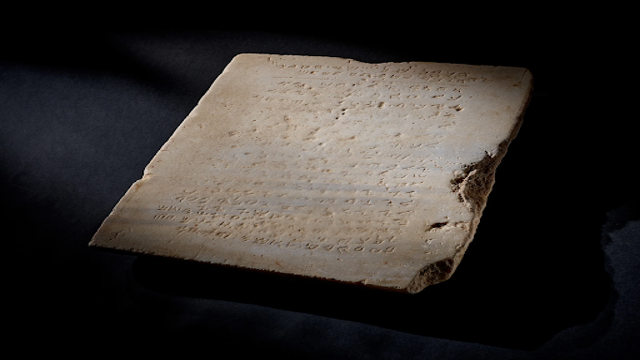
An ancient stone tablet featuring the Ten Commandments, believed to be the oldest of its kind, is expected to sell for as much as $2 million at an auction in December. CNN
The oldest known stone tablet inscribed with the Ten Commandments has sold for $5.04 million, far exceeding its expected price. This historic artifact, which dates back about 1,500 years to the Late Roman-Byzantine period, sparked a heated bidding war during a sale at Sotheby’s New York. The anonymous buyer plans to donate the tablet to an Israeli institution.
Weighing 115 pounds and standing two feet tall, the stone was discovered in 1913 during the construction of a railway in the southern part of modern-day Israel. It was found near the remains of ancient synagogues, mosques, and churches, but its significance went unrecognized for many years. For about 30 years, it was used as a paving stone outside a home, with the inscription exposed to heavy foot traffic.
The tablet, inscribed in Paleo-Hebrew script, displays the Ten Commandments, which are central to many world religions, including Judaism and Christianity. Despite its initial disregard, the stone's historical value was eventually recognized. In 1943, a scholar purchased the tablet and identified it as a significant Samaritan Decalogue — a version of the Ten Commandments central to the Samaritan faith, a monotheistic religion that shares roots with Judaism but holds Mount Gerizim in the West Bank as the dwelling place of Jehovah instead of Mount Zion in Jerusalem.
Samaritans were closely tied to Jewish communities, but their religious practices evolved differently over time, especially after the Roman invasions and the Crusades. Sotheby’s suggests that the original location of the stone, possibly in a synagogue or private dwelling, was destroyed during these historical events.
The ancient stone was displayed at Sotheby’s New York showroom before being auctioned. CNN
The stone features 20 lines of text, closely mirroring the Ten Commandments from the Book of Exodus. However, it only includes nine of the Ten Commandments, omitting the commandment, "Thou shalt not take the name of the Lord in vain." In place of this, a directive to worship on Mount Gerizim is included, reflecting the Samaritan tradition. The significance of this variation provides further insight into the distinct religious practices of the Samaritans compared to mainstream Judaism and Christianity.
Richard Austin, Sotheby’s global head of books and manuscripts, described the tablet as not only an incredibly important artifact but also a tangible connection to the values that have shaped Western civilization. He emphasized that encountering such an item offers a unique opportunity to connect with cultures and faiths that have endured for millennia.
This sale comes after another significant auction of biblical history: last year, a Hebrew Bible over 1,000 years old was sold for $38.1 million at Sotheby’s. That sale set a record, underscoring the continued fascination with and reverence for ancient religious texts and artifacts.
The sale of this ancient tablet serves as a reminder of the enduring impact of the Ten Commandments on law, morality, and the development of Western civilization. This remarkable relic not only offers a glimpse into the ancient past but also reinforces the shared cultural heritage that connects diverse religious traditions today.















